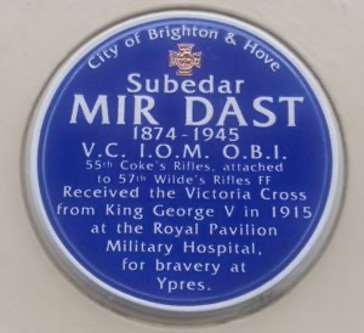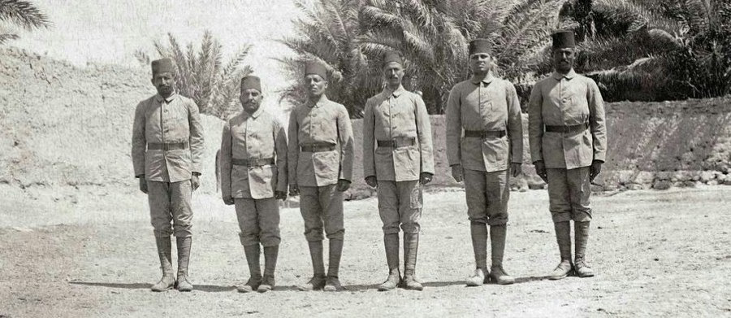Diversifying the Teaching of the First World War
IN NOVEMBER 1914, THE 35TH OTTOMAN SULTAN, MEHMED V, FORMALLY DECLARED JIHAD AGAINST THE ENTENTE POWERS OF THE FIRST WORLD WAR.

Addressing a distinguished audience at Istanbul’s Fatih mosque, Mehmed claimed that Britain, France and Russia had long harboured “ill-will against our great Caliphate”, and that millions of Muslims had suffered misfortune and disaster under their tyranny. He urged his army and navy to fight “as lions” for “the life and existence of both our country and 300 million Muslims”, reassuring them that their efforts would be supported by “the divine help of God and the moral support of our glorious Prophet.”[1] With this, Mehmed signalled the Ottoman Empire’s entry into the first world war, and their intention to incite revolt amongst Muslim populations of enemy-held lands.
Historian David Olusoga makes a convincing case for the ongoing resonance of this moment in his book The World’s War: Forgotten Soldiers of Empire. Olusoga argues that the jihad, leaving in its wake significant political, geographic, religious and ethnic instabilities, ‘became the foundations on which some of the most intractable disputes of the modern age stand’. He notes: ‘The names of the nations and regions to which Germany and its Ottoman allies dispatched their Jihad missions, targeted their propaganda and attempted to foment rebellion seem uncannily like a roll-call of twenty-first-century trouble spots and places of international worry: Egypt, Libya, Iraq, Afghanistan, Iran, Darfur and even Pakistan’s tribal areas.’[2]
As such, it seems that we ought to devote time and attention in our teaching of the First World War to this important – and perhaps overlooked – aspect of the conflict. As a History teacher, I think that it is important for students to develop an awareness of the long reach that such moments of intervention are likely to have; one of the aims of secondary-school History is, surely, to help young people to grasp the fundamental interconnectedness of the past and present. Students should understand, too, that the conflicts of World War One were played out in much more diverse arenas (and with much more diverse armies) than traditional narratives might have us believe.
Planning Key Stage 3 (ages 11-14) enquiries on World War One is a daunting task. The amount of material is seemingly endless and with the constraints of time imposed by students allocated one or two hours of History per week it is difficult to do justice to this complex topic.
Having recently read both Olusoga’s The World’s War and Santanu Das’ India, Empire, and First World War Culture, however, I realised that I was not happy with my rather Eurocentric approach to delivering the topic. Although students explored the web of international relationships (and relationship breakdowns) that contributed to the outbreak of the war, and mention was made of the contributions of ‘Empire soldiers’ to the cause, I gave students little opportunity to grasp the impact of the conflict on diverse and distant populations, and to engage with the real, lived experiences of non-white, non-European soldiers.
I decided, therefore, to use the contrasting stories of two Indian brothers – Mir Dast and Mir Mast – to explore some of the challenges, triumphs and tragedies of the first world war, and to exemplify the impact which a combination of circumstance and character had upon the experiences of individual soldiers compelled to fight on behalf of the imperial powers.

The brothers were extracted from their village of Tirah (close to the border between modern-day Pakistan and Afghanistan) to fight for the British army on the Western Front. Mir Dast was commended for his gallantry during the second Battle of Ypres, having assisted in carrying eight British and Indian officers to safety whilst under heavy fire. Mir Mast was posted to the front line in France, but he and a number of colleagues deserted their camp at Neuve Chapelle, defecting to the German side.
Mir Mast was subsequently sent by the German army on a diplomatic mission to Afghanistan, where his local knowledge was utilised in efforts to persuade the emir of Afghanistan to commit support to the Germans, and to foment uprising against British colonial rule. It is thought that Kaiser Wilhelm II awarded Mir Mast the Iron Cross for his participation in this (ultimately unsuccessful) mission, whilst Mir Dast won the Victoria Cross for his bravery at Ypres.[3]
Mir Mast’s story offers a valuable opportunity to explore individual agency in the context of a war whose soldiers tend to be dehumanised by the industrial nature of death and destruction.
When delivering the first world war topic to year 9 students in 2021, I plan to introduce students to Mir Mast through this question: Why did Mir Mast defect to the German army in 1915?
Students will study and categorise a range of evidence – British army records of his desertion, drawings Mir Mast made of allied trench positions in an apparent effort to convince the German army of his usefulness – before deciding upon the most important motives for his actions.
Olusoga suggests that Mir Mast’s ultimate motivation may have simply been a desire to plot a route back home. In this he was successful, with British records noting that Mir Mast found himself back in Tirah by June 1915.
The story of Mir Mast may serve, as a ‘way in’ to discussing the ideas and attitudes of imperial subjects, and the ideological, religious and political allegiances (or perhaps the lack of such allegiances) which ordinary soldiers felt towards either their British or German masters.

I plan to use the experiences of Mir Mast and Mir Dast as the lens through which to explore other aspects of the war, too.
From online records for the 57th Wilde’s Rifles (Frontier Force) it is possible to draw inferences and promote interesting discussion about the strategies and tactics used in this global conflict: the treatment of troops on the front line; the wartime experiences of colonial soldiers; the diverse composition of first world war infantry regiments.
I hope that by focusing students’ attention on real men who served in the war, students will appreciate the human impact of this monumental conflict and understand the additional dislocation and horror that must have been experienced by colonial soldiers impelled to serve in unfamiliar arenas, alongside unexpected allies and against adversaries for whom they felt no genuine animosity.
Ultimately, the jihad which Mir Mast was tasked with helping to incite came to nothing. The emir of Afghanistan refused to commit his support to the Germans, and indeed the anticipated uprisings and revolutions by Muslim populations across British and French-held territories did not really materialise – at least not on the scale which Mehmed V and the German Kaiser had hoped. However, the movement was only really in its infancy in the years 1914-18. As Italian writer Leone Caetani concluded in The New York Times as early as 1919, ‘The entire Oriental world, from China to the Mediterranean, is in ferment. Everywhere the hidden fire of anti-European hatred is burning.’[4]
Anti-colonial struggles were to manifest themselves in further jihadist movements of the twentieth and twenty-first centuries, and the legacy of these early stirrings was to be felt in the development of nationalist and fundamentalist ideologies across the region.
Familiarising students with the early expressions of such a movement seems to be of great value and doing so through the stories of ordinary soldiers will cement the ‘human’ element of these big narratives.
I hope, too, that it will serve to complicate notions of heroism, chauvinism and bravery which students seem to attach in an uncomplicated (and worryingly exclusive) way to the ‘British’ forces of the first world war. In studying the stories of Mir Dast and Mir Mast, students will gain a better understanding of the diverse nature of the battles, soldiers and geographies of the war – but also of the deep fault-lines that were carved by the conflict, the consequences of which remain highly pertinent today.
Elena Stevens teaches History at St Philip Howard Catholic School in West Sussex. Before this she completed her PhD at the University of Southampton, with a focus on popular entertainment in the long nineteenth century.
References:
-
Proclamation of war, as read by Sultan Mehmet Reşad on November 11th, 1914 in Istanbul http://www.turkeyswar.com/documents/ .
-
D. Olusoga, The World’s War: Forgotten Soldiers of Empire (2014), pp. iv-v.
-
See ibid. for a full account of Mir Mast and Mir Dast’s experiences.
-
L. Caetani, special cable to the New York Times, dated Rome, May 28, 1919
